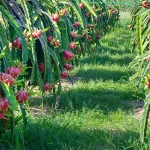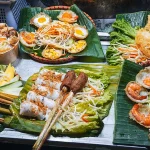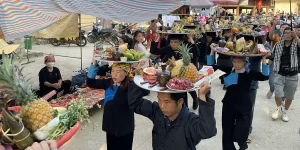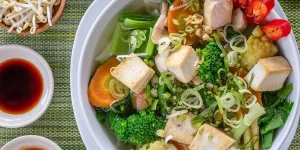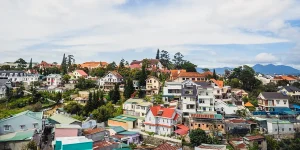Meat sizzles over charcoal in the center of Ho Chi Minh City, while in Hanoi’s old quarter a quiet pot of phở simmers on a street corner. Vietnamese street food isn’t a separate category. It’s the same food locals eat daily, just prepared and shared outdoors. Almost everything that people eat at home or in restaurants can also be found at small sidewalk stalls, rolling carts, and tiny open-air kitchens.
Of course, there are a few specialties that require some searching, like the raw duck blood soup or regional insect salads, but these are exceptions. The rule is simple: what you see on the street is the everyday heart of Vietnamese cuisine.
When preparing this guide, we focused on the most rooted and widely loved dishes—those that locals eat daily and that you can find in most cities. Still, not every dish tastes the same everywhere. Each region has its own style, ingredients, and traditions. Knowing where to try each dish matters just as much as knowing what to try.
If you prefer meat-free options, many iconic dishes have vegetarian (chay) versions at street stalls nationwide — see our full guide to the Vegetarian Food in Vietnam for detailed tips.
Table of Contents
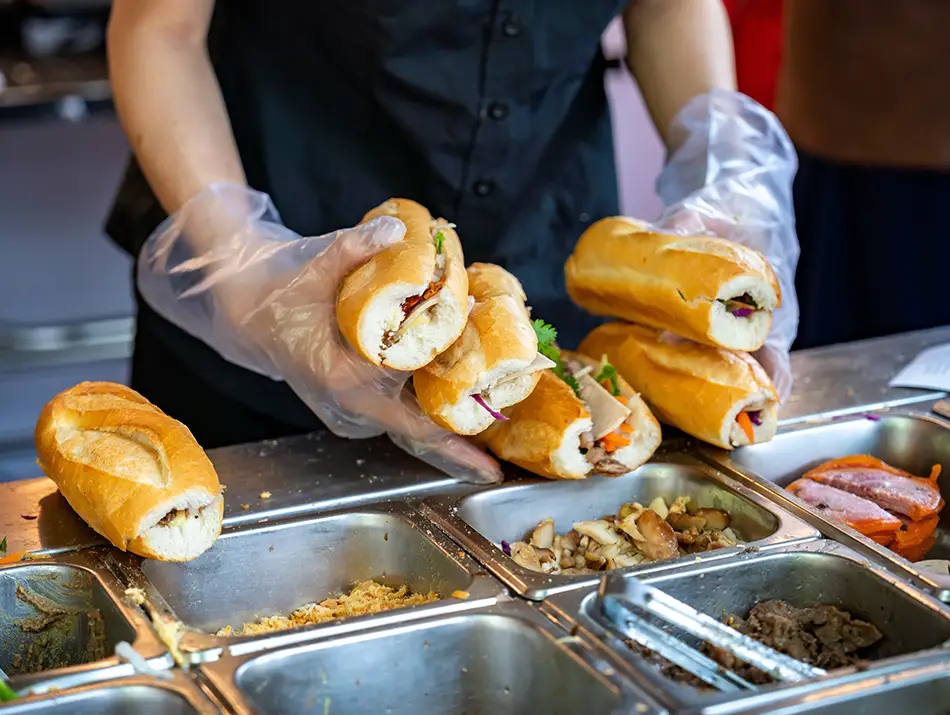
10 Best Vietnamese Street Food Dishes
Pho Bo:
Beef noodle soup with rice noodles in clear broth, thin-sliced raw beef that cooks in the bowl, served with basil, lime, and chili. Hanoi claims the original version from the 1920s.
Banh Mi:
Crusty baguette filled with pate, cold cuts, pickled carrots, cucumber, cilantro, and chili. French bread met Vietnamese fillings in the 1950s.
Bún Chả:
Grilled pork patties and belly slices over rice vermicelli, with herbs and nuoc cham dipping sauce. Hanoi’s midday staple, made famous by Obama in 2016.
Bún Bò Huế:
Spicy beef noodle soup from central Vietnam, with lemongrass, shrimp paste, round rice noodles, and pork knuckle. Hue’s royal kitchens influenced the intense broth.
Gỏi Cuốn:
Fresh spring rolls of shrimp, pork, vermicelli, and herbs wrapped in rice paper, dipped in peanut sauce. Light northern snack or southern meal starter.

Bánh Xèo:
Crispy rice flour crepe folded over shrimp, pork, and bean sprouts, eaten by wrapping pieces in lettuce with herbs. Southern style runs larger and crunchier.
Bánh Tráng Nướng:
Grilled rice paper topped with egg, dried shrimp, scallions, chili sauce, and folded like a taco. Dalat’s cold nights birthed this street pizza.
Chả Giò:
Fried spring rolls stuffed with pork, shrimp, mushrooms, and glass noodles, served with nuoc cham. Smaller and crispier in the south.
Cơm Tấm:
Broken rice topped with grilled pork chop, fried egg, pickled vegetables, and scallion oil — a classic of Vietnamese street food and Saigon’s working-class fuel since the 1940s.
Banh Bao:
Steamed buns filled with pork, sausage, egg, and mushrooms. Chinese-Vietnamese fusion common at bus stations.
Bonus for thrill seekers: Trứng Vịt Lộn – Fertilized duck egg boiled at 17-19 days, eaten with salt, pepper, and rau ram herb. Night markets sell them cracked open in the shell.
Good to Know
For a deeper look at how street food shapes daily life across the country, read BBC Travel’s feature on Vietnam’s vibrant street food culture
Vietnamese Street Food Map
Hanoi: Charcoal, Herbs, and Morning Broth
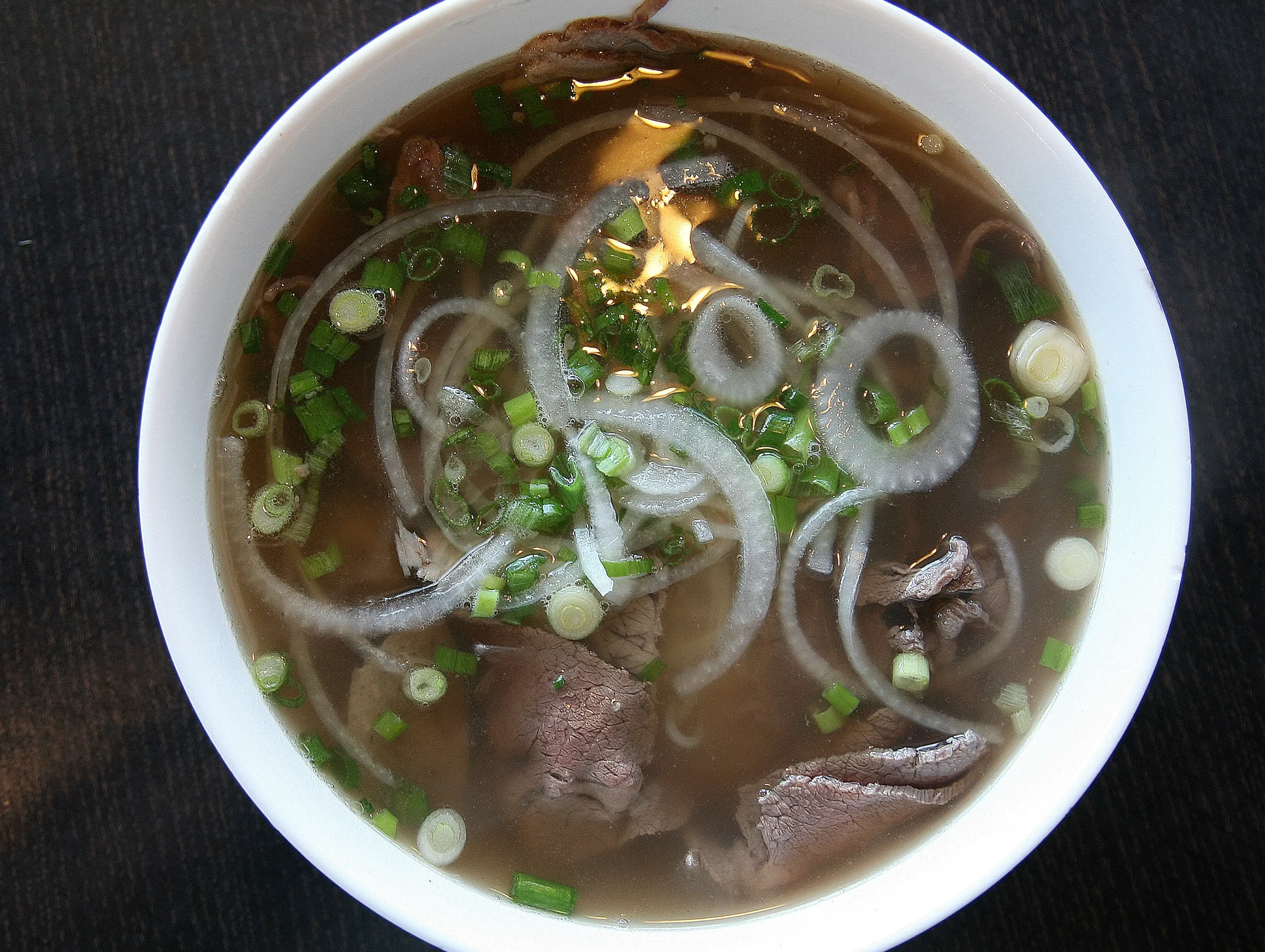
Hanoi’s street food scene starts early, when the air smells of broth, charcoal, and fresh herbs. Sidewalk vendors set up metal pots and low stools before sunrise, serving locals hurrying to work. Mornings are the best time for soups and grilled meats, while evenings fill with sizzling skewers and beer stalls.
The Old Quarter’s rhythm follows the day: breakfast crowds fade by midday, replaced by the evening’s hum of locals sharing plates over cold beer. Winter’s cool, dry air gives Hanoi food its comforting depth — simple ingredients, bold flavor, and no rush.
Famous local street food dishes:
- Bún chả: Grilled pork patties served with rice noodles, herbs, and light dipping sauce.
- Pho bo: Clear beef noodle soup with fresh herbs, lime, and chili on the side.
- Chả cá: Turmeric-marinated fish grilled with dill and served with rice noodles.
- Bánh cuốn: Steamed rice rolls stuffed with minced pork and mushrooms, topped with fried shallots.
Best street food locations:
Ta Hien Street and Ma May Street in the Old Quarter, Hang Buom Street for late snacks, Dong Xuan Market food court.
Ho Chi Minh City: Late-Night Grills and Broken Rice
Saigon moves at a faster pace. Its street food lives under neon lights and open umbrellas, with vendors grilling meat late into the night. You can eat almost anything here, from a simple bowl of noodles to organ stews or crusty baguettes packed with fillings.
The wet season brings sudden rain, but stalls reopen within minutes once the storm passes. Street food here is generous, loud, and constant — matching the city’s restless rhythm.
Famous local street food dishes:
- Cơm tấm: Broken rice with grilled pork chop, shredded pork skin, and fried egg.
- Banh mi: Short baguette with pate, cold cuts, pickles, and herbs — the city’s iconic breakfast.
- Hủ tiếu: Southern-style noodle soup with pork, seafood, and a slightly sweet broth.
- Phá lấu: Slow-cooked offal stew in coconut milk, served with bread or rice.
Best street food locations:
Vĩnh Khánh Food Street in District 4, Cô Giang Street in District 1, Nguyễn Thượng Hiền Street in District 3, Bến Thành Night Market area.
Da Lat: Cool Air and Late-Evening Snacks

Da Lat, in the Central Highlands, eats differently. The city’s cool air and misty evenings invite warm street food and small fires on sidewalks. Locals gather around sizzling grills or steaming pots after dark, wrapped in jackets rather than T-shirts.
Fresh vegetables and dairy from nearby farms shape many dishes, making them lighter and more balanced than the coast’s seafood-heavy fare. Nights at the central market feel cozy, almost alpine, with vendors pouring hot soy milk and frying rice paper pizzas under yellow lights.
Famous local street food dishes:
- Bánh tráng nướng: Grilled rice paper topped with egg, sausage, scallions, and chili sauce.
- Hot soy milk (Sữa đậu nành): Sweetened soy drink served warm, often with steamed buns.
- Grilled skewers: Pork, chicken, or mushrooms grilled on open coals with chili salt.
- Avocado ice cream (Kem bơ): Smooth avocado blended with ice cream, a Da Lat specialty dessert.
Best street food locations:
Đà Lạt Night Market on Nguyễn Thị Minh Khai Street, side alleys around the market and Hòa Bình Area for late snacks.
Hue: Broths with Backbone
Hue’s cooking carries traces of its imperial past — refined recipes and attention to detail. This city adds a royal touch to Vietnamese street food, waking to steaming bowls of lemongrass broth and chili, hearty enough to balance the morning chill. Lunch brings delicate rice cakes and banana leaf parcels filled with shrimp paste or pork.
Hue’s wet season often floods streets, yet vendors stay open, cooking under awnings and umbrellas. It’s a city that values flavor over comfort.
Famous local street food dishes:
- Bún bò Huế: Spicy beef noodle soup with lemongrass and thick round noodles.
- Bánh bèo: Steamed rice cakes topped with minced shrimp and crispy shallots.
- Bánh nậm: Flat rice cakes filled with minced pork and shrimp, wrapped in banana leaves.
Best street food locations:
Đông Ba Market and its surrounding stalls, Trần Quang Khải Riverside Strip, Nguyễn Đình Chiểu Walking Street.
Hoi An: Lantern Lanes and Snack-Sized Bites

Hoi An’s street food scene is compact but diverse. The old town’s yellow walls hide small kitchens serving local recipes unchanged for generations. Crowds come early, so mornings and late afternoons are the best times to explore. The dishes are lighter, often made for quick bites between walks — a legacy of a trading port used to feeding travelers.
Famous local street food dishes:
- Cao lầu: Noodles with pork, herbs, and crispy crackers, made with water from Hoi An’s ancient wells.
- White rose dumplings: Steamed shrimp dumplings shaped like flowers, delicate and translucent.
- Banh mi: Hoi An’s version mixes pate, barbecue pork, and chili sauce — often considered the country’s best.
Best street food locations:
Hoi An Central Market (at Trần Phú and Nguyễn Huệ), An Hội Night Market (across the river), and side streets off Trần Phú and Nguyễn Thái Học.
Da Nang: Markets Built for Eating
Da Nang sits between mountains and sea, and its food shows both influences. Markets are designed for quick eating — rows of noodle stalls, fish cake counters, and sizzling skewers all in one place.
Street food here is practical and filling, often served in modest portions so you can try several dishes in a single visit. Locals eat fast, talk little, and always add fresh herbs.
Famous local street food dishes:
- Mì Quảng: Turmeric noodles with pork, shrimp, and crushed peanuts, served with minimal broth.
- Bánh tráng cuốn thịt heo: Pork slices wrapped with herbs and rice paper, dipped in fermented fish sauce.
- Nem lụi: Grilled pork skewers served with rice paper and fresh greens for rolling.
Best street food locations:
Cồn Market Food Hall (119 Ông Ích Khiêm Street), Helio Night Market (Đường 2 Tháng 9), and streets around Hàn Market (119 Trần Phú Street).
Nha Trang: Seafood First
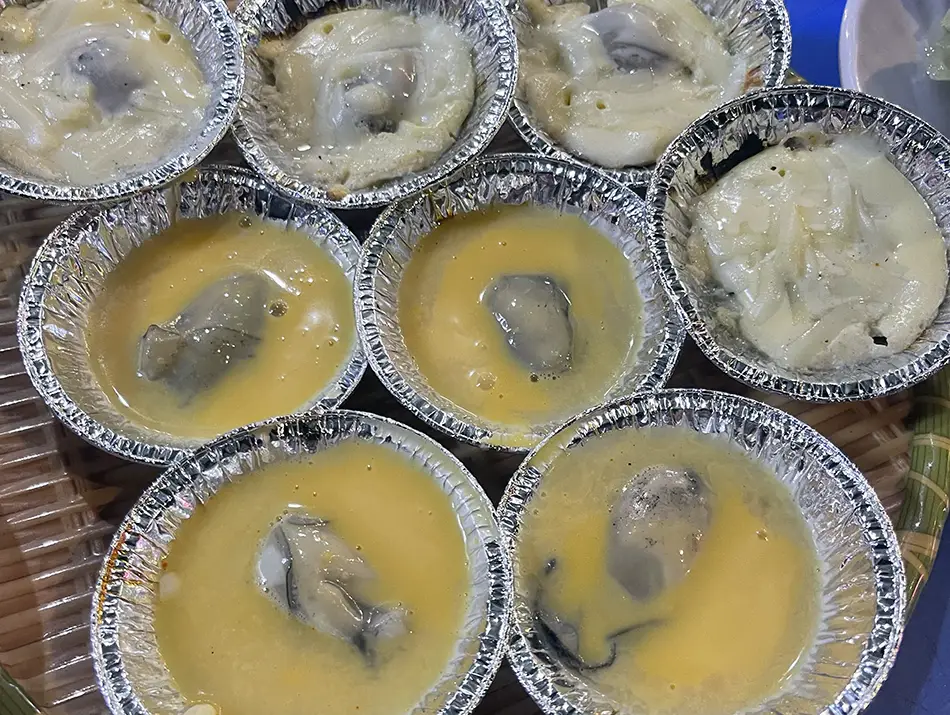
Nha Trang’s mornings begin with the smell of grilled fish and bowls of noodle soup flavored by the sea. As one of Vietnam’s busiest fishing ports, freshness defines its food. Vendors cook what arrives from the boats each morning, close by noon, and reopen at sunset for grilled seafood and coastal snacks.
The atmosphere is relaxed, with beachside stools replacing narrow city lanes.
Famous local street food dishes:
- Bánh căn: Mini rice cakes cooked in clay molds, topped with shrimp or squid and dipped in fish sauce.
- Bún cá: Fish noodle soup with clear broth, herbs, and sometimes jellyfish.
- Grilled skewers: Fresh seafood or pork grilled over charcoal, brushed with chili oil.
Best street food locations:
Xóm Mới Market (49 Nguyễn Thiện Thuật Street), streets off Nguyễn Thiện Thuật near the beach, and the perimeter of Đầm Market (09 Nguyễn Trãi Street).
Can Tho: River Breakfasts
Can Tho, the Mekong Delta’s largest city, blends food and water. Morning life starts on boats where vendors cook bowls of noodles among piles of fruit and flowers. Floating markets serve breakfast to travelers and locals alike, and by midday, the energy shifts to quiet riverside alleys. Tropical fruit stalls take over in the afternoon, offering fresh-cut pineapple, mango, and jackfruit.
Famous local street food dishes:
- Hủ tiếu gõ: Clear pork noodle soup served from mobile pushcarts that knock to announce arrival.
- Bánh xèo miền Tây: Crispy Mekong-style rice crepe filled with shrimp, bean sprouts, and herbs.
- Tropical fruit snacks: Sliced seasonal Vietnamese fruits often served with chili salt or coconut milk.
Best street food locations:
Cái Răng Floating Market (on the Hậu River, 5 mi / 8 km from city center, reachable by boat from Ninh Kiều Wharf) and Ninh Kiều Riverside Night Market area.
Vietnamese Street Food Safety

Street food in Vietnam is part of daily life, so it is generally prepared fast and served fresh. Still, it helps to be mindful, especially in your first days when your stomach is adjusting to new broth styles, raw herbs, fish sauce, and chili heat.
Choose stalls with local traffic, not just tourists. High turnover is the most reliable sign of freshness. Watch how the vendor handles ingredients.
Eating earlier is safer. Morning markets and breakfast stalls work through ingredients quickly. Lunch spots restock around late morning. In the afternoon heat, avoid dishes that look like they have been sitting in trays for long. Evening grills tend to be safest after 5:00 p.m. when stalls fire up fresh.
Adjusting to Chili and Herbs
Vietnamese food has layers of flavor: saltiness, sourness, umami, and heat. If you load everything with chili from day one, your stomach may react, not because the food is unsafe but because it is different from what you are used to.
For detailed food and water safety advice, refer to the U.S. CDC’s official travel health guidelines.
Finding the Most Authentic Street Food in Vietnam

Skip the neon-lit tourist strips. Walk three blocks past the backpacker hostels into alleys where laundry hangs above and kids kick soccer balls. Look for the spots where motorbike taxi drivers stop for lunch—that’s often where the real flavor hides. A stall serving only one or two dishes will usually outperform those offering a long list.
Respect local meal times. Breakfast dishes can sell out by 9:00 a.m. Lunch peaks between 11:30 a.m. and 1:00 p.m. Dinner stalls start setting up around 5:00 p.m., and some snacks appear only late at night. When a place cooks one thing and serves it fast, take a seat.
From Street Stalls to Deeper Flavors
We hope this guide keeps you pointed toward the right plastic stool in your search for the best Vietnamese street food. If you’re into deeper gastronomic travel, explore our article “35 Best Dishes to Try in Vietnam”, which includes a free interactive PDF to help you track every dish you taste along the way, so none go forgotten.
Keep your chopsticks ready and your curiosity open.

